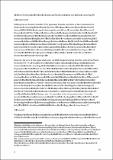Files in this item
J.B. Ward-Perkins, the BSR and the landscape tradition in post-war Italian archaeology
Item metadata
| dc.contributor.author | Smith, Christopher John | |
| dc.date.accessioned | 2017-11-13T10:30:18Z | |
| dc.date.available | 2017-11-13T10:30:18Z | |
| dc.date.issued | 2017-10-26 | |
| dc.identifier | 251521044 | |
| dc.identifier | 4e59feea-8c24-4f36-8324-0417069c115a | |
| dc.identifier | 85033396439 | |
| dc.identifier | 000447002200010 | |
| dc.identifier.citation | Smith , C J 2017 , ' J.B. Ward-Perkins, the BSR and the landscape tradition in post-war Italian archaeology ' , Papers of the British School at Rome , vol. In press . https://doi.org/10.1017/S006824621700037X | en |
| dc.identifier.issn | 0068-2462 | |
| dc.identifier.other | ORCID: /0000-0002-6049-5514/work/66398304 | |
| dc.identifier.uri | https://hdl.handle.net/10023/12063 | |
| dc.description.abstract | Nothing has so characterized the British School at Rome's approach, from its inception, as the commitment to landscape archaeology in one form or another. This paper discusses the origins of this commitment in the work of Thomas Ashby, but focuses on the major contribution of J.B. Ward-Perkins and the South Etruria Survey. This survey is set in the context both of intellectual developments in landscape archaeology, and the specific circumstances of the BSR, and its Director, after the Second World War. The article traces the impact of this work on subsequent landscape archaeology. | |
| dc.format.extent | 22 | |
| dc.format.extent | 489067 | |
| dc.language.iso | eng | |
| dc.relation.ispartof | Papers of the British School at Rome | en |
| dc.rights | © British School at Rome 2017 . This work has been made available online in accordance with the publisher’s policies. This is the author created accepted version manuscript following peer review and as such may differ slightly from the final published version. The final published version of this work is available at https://doi.org/10.1017/S006824621700037X | en |
| dc.subject | Landscape archaeology | en |
| dc.subject | CC Archaeology | en |
| dc.subject | Archaeology | en |
| dc.subject | T-NDAS | en |
| dc.subject.lcc | CC | en |
| dc.title | J.B. Ward-Perkins, the BSR and the landscape tradition in post-war Italian archaeology | en |
| dc.type | Journal article | en |
| dc.contributor.institution | University of St Andrews.School of Classics | en |
| dc.contributor.institution | University of St Andrews.Institute of Legal and Constitutional Research | en |
| dc.identifier.doi | 10.1017/S006824621700037X | |
| dc.description.status | Peer reviewed | en |
This item appears in the following Collection(s)
Items in the St Andrews Research Repository are protected by copyright, with all rights reserved, unless otherwise indicated.

